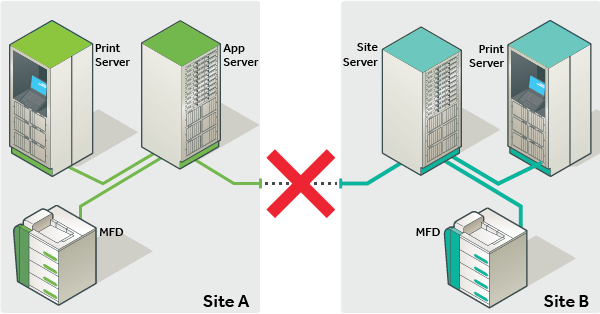Technical overview
The goal of the Site ServerSite Servers take over the role of a Primary Application Server in the event of network outages. Key roles taken over include authentication, copy and print tracking and Find-Me printing. Site Servers ensure continuous availability of printing resources to support key business functions over unreliable network links or during unplanned network disruptions. is to support access to printing and copying, and is designed to be implemented with equal ease for existing PaperCut customers and new PaperCut Customers. The diagrams below highlights the change in design for existing customers implementing a Site Server, or for new customers that want to incrementally build a solution and phase a Site Server in after a basic single server solution is functioning.

Figure 15: WITHOUT Site Server

Figure 16: With Site Server
These images show the changes in how elements of a PaperCut solution communicate when a Site Server is deployed.
-
MFDs now communicate with the Site Server. This ensure an outage between Site Server and Application ServerAn Application Server is the primary server program responsible for providing the PaperCut user interface, storing data, and providing services to users. PaperCut uses the Application Server to manage user and account information, manage printers, calculate print costs, provide a web browser interface to administrators and end users, and much more. is defended by the Site Server.
-
Print servers also communicate with the Site Server when the Application Server is unavailable.
During normal operation where the Site Server and the Application Server are connected, the two servers together deliver the full set of PaperCut functionality. In anticipation of an outage, the Site Server also caches an up to date set of Application Server data.
In the unlikely event of an outage, the Site Server immediately takes over to deliver business continuity. When the link is re-established, normal operation resumes and offline job logs and transactions are submitted to the Application Server.
What you will need
The Site Server implements the core functions of the Application Server, and as such the majority of requirements are the same.
| Operating System | All eligible choices for an Application Server. Can be chosen independently from the Application Server. |
| Database | All eligible choices for an Application Server. Can be chosen independently from the Application Server. |
| Database licensing | PaperCut database replication is provided by PaperCut. No database enterprise licensing is required. |
| Server specs | Follow the suggested sizing requirements of the Application Server. |
| SSLSecure Sockets Layer (SSL) is the standard security technology for establishing an encrypted link between a web server and a browser. This link ensures that all data passed between the web server and browsers remain private and integral. The protocol uses a third party, a Certificate Authority (CA), to identify one end or both end of the transactions. To be able to create an SSL connection a web server requires an SSL certificate. When you choose to activate SSL on your web server you will be prompted to complete a number of questions about the identity of your website and your company. Your web server then creates two cryptographic keys - a Private Key and a Public Key. | Server to server communication is encrypted by default. We recommend using a certificate for your Application Server signed by a CA. Your CA of choice should provide instructions for your installation. |
| Versioning | Your Application Server must be v15.0 or greater, and your Site Servers must be of the same version. |
| Licensing | The Site Server component is a license feature of the PaperCut Application. Licenses must be arrange prior to installation. |
| Ports | Site Server: The Site Server listens on port 9191 for Print ProviderA Print Provider is a monitoring service installed on a secondary print server to allow PaperCut to control and track printers. This monitoring component intercepts the local printing and reports the use back to the primary Application Server. connections and the inbound ports for your chosen Device Connections. Application Server: The Application Server listens on port 9192 for connections from the Site Server and 9191 for Print Provider connections. |
Where to deploy
An effective way to consider where a PaperCut Site Server should be deployed is to install a Site Server in any network segment where you have concerns about the link reliability between this segment and the Application Server and an outage to this segment would impact your business.
Remote sites
City offices
Separate campuses
Individual buildings with poor links
Local sites where servers are on the Private Cloud
Where to deploy
An effective way to consider where a PaperCut Site Server should be deployed is to install a Site Server in any network segment where you have concerns about the link reliability between this segment and the Application Server and an outage to this segment would impact your business.
Remote sites
City offices
Separate campuses
Individual buildings with poor links
Local sites where servers are on the Private Cloud
